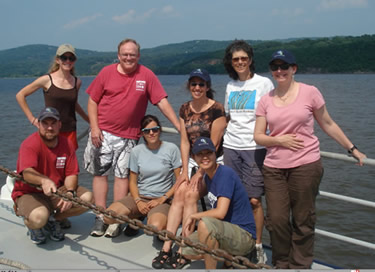
|
|
|
|
|
|
|
|
Core Participants: Alessandra Leri, Dora Kwong, Maija Niemstro, Ann LePore, Tim Kenna, Margie Turrin.
Today's Bloggers: Miriam Straus and Rick Hoff
Day Participant: Gil Hanson |
| Early morning for all, as we arrived ON TIME to board SUNY Stony Brook University's R/V Seawolf captained by Stephen Cluett and the crew Pat and James. |
|
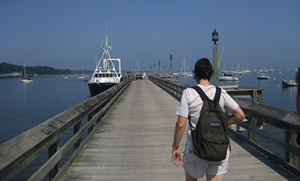 Loading the boat at Port Jefferson
Loading the boat at Port Jefferson |
|
|
|
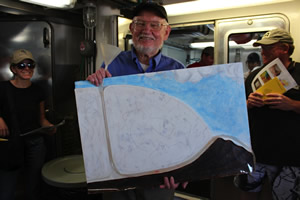
Gil Hanson and his model of water running uphill under a glacier. |
|
This is a first for River Summer, starting the cruise at the R/V Seawolf home port, Port Jefferson, and studying Long Island. After an orientation on deck with Margie, we met our guide and mentor for the day, Dr. Gilbert Hanson. Gil is a Geologist with SUNY Stony Brook and held us in rapt attention as he laid out for us the story of the creation of Long Island. His discussion included the answer to the question, “When does water run uphill?” which he demonstrated with a totally indisputable working model.
After a tour of this historic section complete with history, we discussed an area in search of an identity… is it a historic district? is it a maritime museum? Is it a community? Inevitably the discussion of preservation is tightly linked with continued funding.
He created a timeline that took us from ice tunnels to animal trails to Indian trails, to settler tracks and ended as Route 25A! This was a new way of looking at a developed area and seeing underneath it to reveal how natural land forms evolved. Wow! |
| |
|
|
He then led us into the woods and hills and even parking lots (!) around Port Jefferson, where he showed us how an inspirational teacher can lead his students to not just understand, but visualize a world that is totally outside of our personal experience.
Geologist’s gift is putting a puzzle together with many missing pieces. |
|
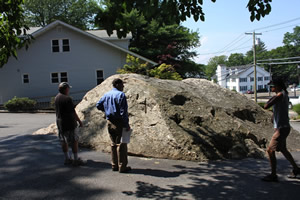 Glacial erratic that refused to be removed and is now embedded in the parking lot!
Glacial erratic that refused to be removed and is now embedded in the parking lot! |
|
| |
|
|
|
|
|
Interesting note about the flora—we saw six foot high Jewel weed.
[Image above: traveling through the jewelweed.] |
|
|
|
| |
We took off on the boat and took measurements at eight different locations moving towards Hell’s Gate.
We were a fine honed team of data collectors.
By the end of the day when Captain Steve announced, “We are on station,” we all jumped into action with no stumbling perceived. |
|
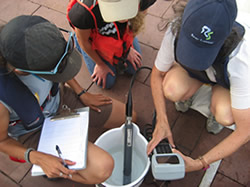 Sampling water quality with the YSI.
Sampling water quality with the YSI. |
|
| |
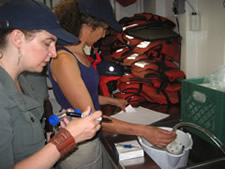 |
|
|
|
|
Filtering water for nutrient sampling. |
|
Alessandra and Rick discussing the chemistry of the enterococcus reagent. |
|
Practicing nautical skills. |
|
| |
|
|
As all teachers, the unanimous agreement was we all love being students!
(Although the bowline knot was challenging many of us as we practiced our nautical skills during the course of the transit through Long Island Sound!)
[Image on left – evening sky as we transited the Sound.]
|
|
|
|
|
| |
|
Core Participants: Alessandra Leri, Dora Kwong, Ann LePore, Tim Kenna, Miriam Straus and Rick Hoff
Today's
Bloggers: Maija Niemstro & Margie Turrin
Day Participants: Michael Koch, Phil Meyer, Arianna Feinberg, Michelle DeCurtis, Roger Panetta, Sabina Marx, Victoria Rosoff, Mike Gerrard |
Day two of River Summer 2011 began with a bright early morning start at the Merchant Marine Academy where the waters of Long Island Sound and the East River meet and mix.
We left the dock with our guest, Roger Panetta from Fordham University leading us through a morning thought exercise to connect us with the waters below the hull of the Seawolf. He posed the question, "Why Study Rivers?" and through verbal prose invited us to consider the poetic, cultural, emotional, artistic and historic importance of the river. |
|
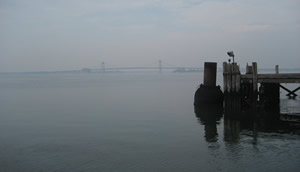 Early morning cast off from Kings Point
Early morning cast off from Kings Point |
|
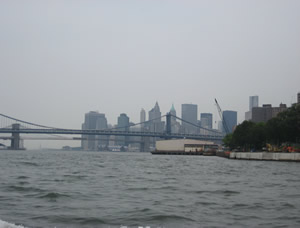 Transiting and viewing the altered shorelines
Transiting and viewing the altered shorelines |
|
The Seawolf dodged ferries, barges, a DEP boat, and pleasure craft as we ducked below all eight bridges spanning the East River.
At slack tide, the passengers and crew were able to take in the extremely altered shoreline of the Bronx, Queens, Brooklyn, and Manhattan Island.
By comparing drawings of the shoreline in 1650 to what was in front of us we were all amazed at how different the wetlands of Manhattan looked now with bulkheads and industrial zones. |
|
| |
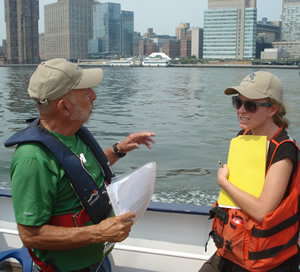 Roger Panetta and Alessandra discuss the East River
Roger Panetta and Alessandra discuss the East River |
|
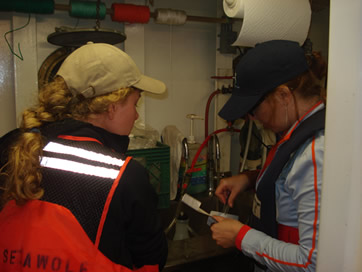 Alessandra and Ann water quality testing
Alessandra and Ann water quality testing |
The point where the water meets the land is vital to human perception of our food sources, our connection to nature and our motivation to protect our waterways. Panetta connected global climate change problems with the many ways Manhattan’s shoreline has been altered, and pointed out examples as the vessel transited between water sampling locations. |
|
We also discussed how the communities on each side of the river can be forever altered by the construction of bridges spanning the natural aquatic lane.
We sat back in awe as suspension and cantilever bridges shaded us momentarily and the vents of underwater tunnels passed from view while trying to imagine how a neighborhoods adjusted to a six lane bridge opening next door.
[Image on right, the group discusses the role of bridges in changing and displacing local communities.] |
|
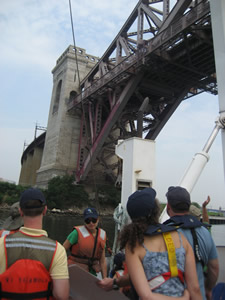 |
|
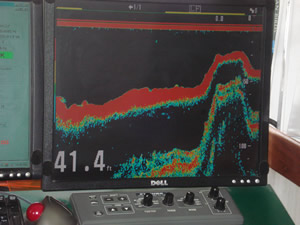 Sonar image of the Hell’s Gate where the rocky shoals have been blasted to flatten them for boat transit.
Sonar image of the Hell’s Gate where the rocky shoals have been blasted to flatten them for boat transit. |
|
Viewing the sonar images of the East River’s bathymetry, Captain Steve pointed out former rock formations that had been blasted intensively with dynamite to make Hell’s Gate a more navigable straight.
We said goodbye to Roger Panetta at Pier 40 and transitioned from our conversations about the history and culture of New York City as an archipelago to the future of the city socially coping with global climate change.
Victoria Rosoff and Sabine Marx from Columbia University's Center for Research on Environmental Decisions presented their recent publication entitled "The Psychology of Climate Change Communication." We learned about the importance of understanding your audience, connecting to their personal experiences and ultimately lubricating the way for positive changes. |
|
| |
The River Summer participants’ highlight for this climate change presentation was a simulation where we became three companies making decisions about polluting or paying to avoid degrading the hypothetical lake. Through surprisingly intense debate and discussion finances waned and water quality suffered as each company either tried to stay true to their environmental ethic, fiscal responsibilities or get away without a fine.
Our enthusiastic group consists of teachers who work with third graders up to those working with West Point Cadets. Each of us learned something from these discussions and activities and will be able to incorporate what we’re learning aboard the Seawolf in our future climate change lessons. |
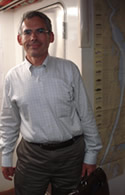 Mike Gerrard stands by images of the striped bass and other fish the Westway case helped to protect.
Mike Gerrard stands by images of the striped bass and other fish the Westway case helped to protect. |
|
After a delicious dinner together, we welcomed our evening speaker Michael Gerrard. He is the head of the Columbia Center for Climate Change Law and thrilled us with his first hand accounts of the biggest environmental law cases of the Hudson Valley.
As Michael explained, environmental law found it’s origin on the shores of the Hudson River in the 1960s with the Scenic Hudson versus the Federal Power Agency case involving Con Edison’s proposed power plant. His first case detailed the famous case of the proposed underground highway, Westway, down the west side of Manhattan, while today he is working on the reconstruction project on the site of the former twin towers.
We were all were amazed with Michael’s career path and ability to explain complex legal issues in an engaging narrative form. |
|
We concluded the day by checking our enterococcus samples that had been incubating over the past 24 hours. None of the samples from the Long Island Sound collected aboard the Seawolf were harboring enterococcus which is a bacteria found in human intestines and is an indicator of combined sewage overflows.
At the end of day two, our water quality tests show that the great legal battles resulting in the Clean Water Act that Michael Gerrard taught us about, and the historical lessons presented by Roger Panetta have done great good for the health of our water. |
|
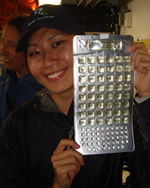 Dora holds an enterococcus sample prepared for incubation.
Dora holds an enterococcus sample prepared for incubation. |
|
|
|
| |
|
Core Participants: Dora Kwong, Tim Kenna, Miriam Straus, Rick Hoff , Maija Niemstro, Margie Turrin
Today's
Bloggers: Alessandra Leri and Ann LePore
Day Participants: Klaus and Isabel Jacobs, Laura Kenna, Katie Kenna, Jack Kenna |
This morning in Battery Park we warmed up with several writing exercises about climate change led by Margie and Tim.
We then struck out in two teams in order to enact our own version of a merged activity from Eve Mosher’s Highwaterline project and a prototype activity called Future Coast.
Using maps, tape measures, and sidewalk chalk, we marked areas which represented the changes in shoreline as affected by an increase in sea level. |
|
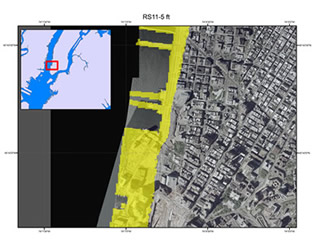
Activity map showing New York City with 5 ft. Sea Level Rise (Map by Arianna Feinberg, CIESIN summer intern) |
|
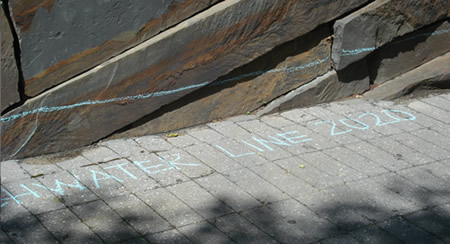
Sea Level Rise line marked on the wall for year 2020
Each team marked three separate areas representing sea level increases in increments of 1.5 foot, 5 foot, and 10 feet. These marks enabled us to visualize the new shape of lower Manhattan, which we found to be radically smaller than the city we’re accustomed to.
The visible lines chalked onto sidewalks and plaza pavers caught the eye of many a pedestrian and several stopped to talk to us about their hopes and concerns regarding the changes that a rising sea level could bring to New York City. |
|
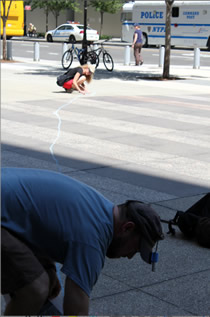 Teams marking Sea Level Rise
Teams marking Sea Level Rise |
|
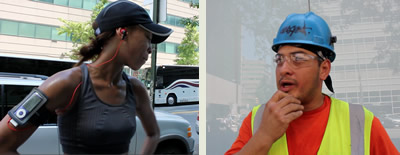
Two New York City residents respond to the activity sharing their concern that there seems to be no attention to the problem by the population. |
|
In addition, we tried to imagine local, regional and global scenarios where coastal flooding could impact things such as food production and availability, transportation, and public services, and how these things would affect us personally, economically, and socially. |
|
At mid-day, we started our transit from Pier 40 up the Hudson River under clear skies, with shards of brilliant sunlight reflecting off the water’s surface. The R/V Seawolf passed the iconic sights of Manhattan’s western riverfront, including the Intrepid battleship and the 79th St. Boat Basin. Near the George Washington Bridge, we noted the sharp delineation where the development of the northern New Jersey stops and the Palisades Park begins.
Although the Palisades appear similar in appearance to the moraines we witnessed on Thursday at Port Jefferson, they were formed through entirely different geological processes, as remnants of a volcanic intrusion that penetrated the bedrock long ago. As the bedrock wore away over eons, the more resilient basaltic sill endured, leaving us with the dramatic elevated flank of the Palisades along the lower Hudson.
We continued our salinity measurements as we traveled upriver, looking for the Hudson River salt wedge, the point where freshwater inputs from the north meet saltwater inputs from the south, with the denser saltwater flowing underneath the freshwater. In general, surface salinity levels decreased predictably as we moved north. As we lowered our CTD probe into the river under the George Washington Bridge, a current in the middle of the water column pulled the probe laterally, a suggestion of the turbulent mixing between the two layers. A Secchi reading of only 80 cm at this site showed that the water was particularly turbid, further evidence of water mixing and resulting suspension of sediments. |
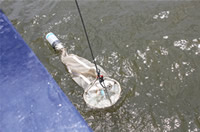 Biological productivity could also make a contribution to the opacity of the water under the Bridge, making it an apt location for a plankton tow. Biological productivity could also make a contribution to the opacity of the water under the Bridge, making it an apt location for a plankton tow.
Our net had a relatively large mesh size, enabling us to capture zooplankton while letting the smaller phytoplankton through.
We sieved out the plankton and examined them under the microscope. Species identification proved tricky, as the microbes zipped around erratically in the field of view, but we were able to spot copepods, tentatively identified as Acartia tonsa Dana, as well as the water flea Moina sp. and several cirripeda, or nauplii larvae for barnacles.
We also observed a species of phytoplankton of the genus Ankistrodesmus.
|
|
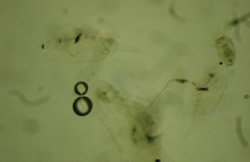 Plankton tow results imaged under a microscope.
Plankton tow results imaged under a microscope.
[click to enlarge] |
| |
|
|
In the meantime, we analyzed the water samples acquired during the past two days, which had been incubating in the presence of the Enterolert reagent, for Enterococci contamination, an indicator of fecal bacteria.
Fluorescence of the incubated sample under longwave UV light indicates that the bacteria have metabolized the reagent, converting it to a fluorescent molecule.
The first seven surface water samples, all collected as we transited west along the Long Island Sound, showed no Enterococci.
However, a sample collected in the East River near Rikers Island, just south of the Hunts Point water treatment plant, tested positive, with a most probable number of 100 Enterococci per liter. |
|
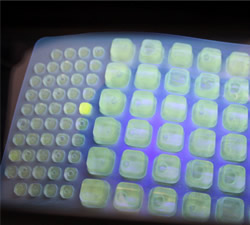 Small fluorescing sample shows evidence of enterococcus
Small fluorescing sample shows evidence of enterococcus
|
|
Just south of the Tappan Zee Bridge, the ship’s crew lowered the nets for a 10-minute trawl along the river’s bottom. The goal of the trawl was to determine the diversity and abundance of aquatic life, and when the crew hauled in a net sagging with the weight of fish, crabs, mollusks, and crustaceans, it provided a heartening confirmation of water quality in the river.
We pulled in abundant Atlantic tomcods, along with 126 hogchokers, three white catfish, eight white perch, three summer flounder, two Atlantic menhaden, one bay anchovy, and one striped bass, among other species. Oysters, an important proxy for ecosystem health, also appeared in abundance. There were 48 male blue crabs and 15 females, reflecting the females’ preference for saltwater to lay their eggs. A piece of Hudson River social history also came up with the net, in the form of a round-bottomed glass bottle of antique origin. |
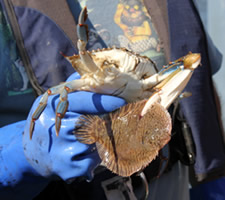 Crab versus Hog Choker
Crab versus Hog Choker |
|
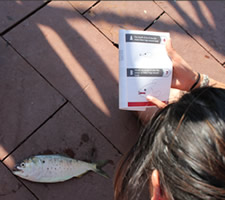 Identifying Herring using the Clearwater Hudson River Fish Key Identifying Herring using the Clearwater Hudson River Fish Key
|
|
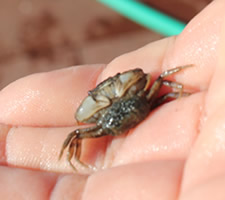 Female mud crab with egg sack
Female mud crab with egg sack |
|
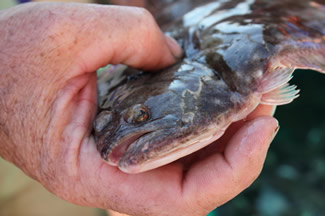 Summer Flounder
Summer Flounder |
|
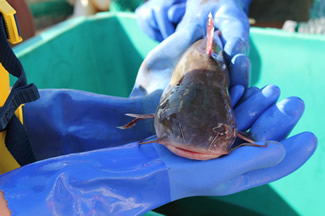 White Belly Catfish
White Belly Catfish |
|
We docked for the evening at Piermont, on the west side of the Hudson south of Nyack, and enjoyed a fine repast prepared on the grill by the chief steward, James.
The evening’s guest speaker, Klaus Jacobs of Columbia University's Lamont-Doherty Earth Observatory, and his wife, Isabella, joined us for the aft deck cook-out, after which Klaus presented his comprehensive assemblage of data and predictions on the effects of climate change in the New York area. To defuse any skepticism about the predictive value of climate models, Klaus began his presentation with the sobering fact that the worst-case scenario for temperature rise predicted a decade ago has, as of 2010, already come true.
He proceeded to map the predicted temperature changes, rainfall averages, sea level rises, and storm surge heights in Manhattan over the next century, mapping for us the areas that would be flooded under various conditions. One of the most striking predictions was that even at current sea levels, a major flood event would inundate significant portions of lower Manhattan, including most of the NYC subway system.
This discussion brought us full circle to this morning’s Future Coast activity in Battery Park, a fitting end to a productive day. |
|
|
|
Core Participants: Tim Kenna, Miriam Straus, Rick Hoff, Maija Niemstro, Margie Turrin, Ann LePore, Alessandra Leri
Today's Bloggers: Dora Kwong and Margie Turrin
Day Participants: Hannes Brueckner, Mary Ann Brueckner, Meryl Nadel, Brent Turrin, Elizabeth Hutchinson |
Day Four of River Summer began with another beautiful morning. As we departed the dock at Piermont, we noted the increase in river traffic around us and observed the number of barges that passed. We soon moved to the bow, where our guest speaker, geologist Hannes Brueckner, from Queens College and Lamont-Doherty Earth Observatory, discussed the evidence of igneous, metamorphic, and sedimentary rock formations surrounding the Hudson River estuary.
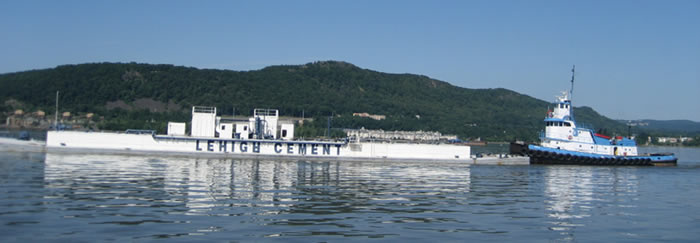
The working Hudson. One of many barges carrying materials up and down the Hudson that we passed in transit. |
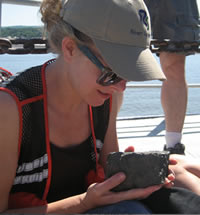 Alessandra examines a rock sample.
Alessandra examines a rock sample. |
|
As the R/V Seawolf moved upstream, Hannes pointed out the Palisades sill located to the west of the Hudson River Estuary. This is a diabase or dolorite formation dated at around 200 million years of age. The sill is an intrusion formed as it pushes into existing rock, similar to a lava flow that never reaches the surface. Hannes helped us envision the full extent of the formation; what we are seeing is like the top edge of a book with the rest of the rock formation dipping down behind into the Earth. Hannes brought a sample of a columnar joint, a cooling joint characterized by six sides formed by the natural contraction of rocks and mud to form hexagons. The Palisades’ sill forms a beautiful and lush natural barrier to the river, with a noticeable lower area in Sparkill, causing some to believe that the Hudson flowed southwest into New Jersey at one time, perhaps following the path of the Hackensack. |
|
The setting formed a great backdrop to discussing three major orogenic events that form the Appalachian cycle: the Taconic Orogeny (450 million years ago), the Acadian Orogeny (380 million years ago), and the Allegheny Orogeny (230 million years ago) part of the closing of Iapetus, the precursor to the Atlantic. The East side of the river includes Fordham gneiss, Manhattan schist, and granitic rocks. As we moved further upriver we passed through the Hudson Highlands formed very early as part of the Grenville orogeny.
The mountain building events are part of the rich geologic history of the Hudson Valley, and are evidenced in the varied rock layers unique to each orogeny in the forming and reforming of sections of the Hudson Valley. |
|
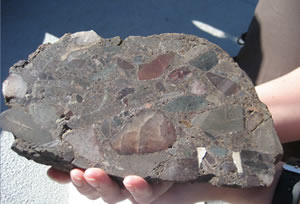
A conglomerate used in the discussion of the geology of the Hudson |
|
As the Seawolf continued on its course, passing the Indian Point Power Plant, we stopped twice for more water sampling. Near Croton, our testing showed increasingly turbid waters, with visibility dropping to 65 cm, as well as the expected lower salinity levels (0.61 ppt). The second measurement continued in this fashion, with a Secchi reading of 75 cm, and salinity at 0.12 ppt.
We docked at noon at West Point where the crew and participants enjoyed a hearty and delicious lunch made by the R/V Seawolf’s cook, James. Yum!
Well-fed and ready to go, we departed with our guests to Storm King Art Center, an outdoor gallery that celebrates the relationship between art and nature. There, we met with Elizabeth Hutchinson, an art expert from Barnard College, who discussed the ways in which we communicate through art forms. With the sun shining brightly overhead, our group observed large-scale sculptures that interacted with the elements, the passage of time, and the viewers themselves. The constant evolutions of these large-scale sculptures beg interesting inquiries relating to the juxtaposition of man-made materials with our natural world. |
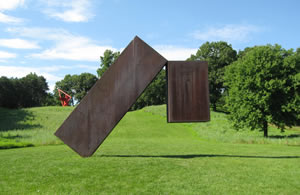 Storm King Art Center – large-scale sculptures placed in the natural world provoke a thoughtful interaction with the piece and the space.
Storm King Art Center – large-scale sculptures placed in the natural world provoke a thoughtful interaction with the piece and the space. |
|
Elizabeth led us to three distinct art pieces, where we contemplated the ways in which art display science.
The first, Schunnemunk Fork, by Richard Serra, consisted of four iron slabs sunken into the well-manicured lawns of the landscape. Each slab, between 20-30 feet long and 2 ½ - 8 feet high, effectively framed the viewers’ line of sight toward Schunnemunk. Depending on one’s vantage point, the viewer’s perception of their depth and thickness changes, piquing interest and provoking interaction. |
|
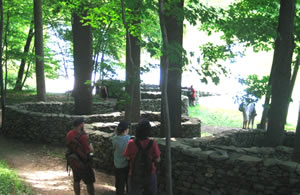 Andy Goldsworthy’s “Wall That Went For a Walk” at Storm King Art Center
Andy Goldsworthy’s “Wall That Went For a Walk” at Storm King Art Center |
|
The second installation we observed was the famed Storm King Wall, by Andy Goldsworthy. His sinuous, undulating stone wall intimately curves around single trees, and effectively connects with the remnants of a former stone wall left behind from farmers who previously occupied the land.
The third art piece, created by Maya Ying Lin, entitled Storm King Wave Field, conveyed the idea of sound or ocean waves. Up to 20 feet high, her sustainable, long-term structures interact with the lush foliage backdrop, which evolve with the passage of seasons. |
|
| After breaking up into groups and exploring other areas of the sculpture park, we discussed the effects of manipulated art and surroundings on interaction and contemplation. We noted the abundant species of plants and trees, which brings the creation of habitats for varied animals, such as insects and birds. Framed by sky and grass, our visit to Storm King provoked thoughtful conversations on the importance of preserving our natural world, and the need for action in response to climate change. |
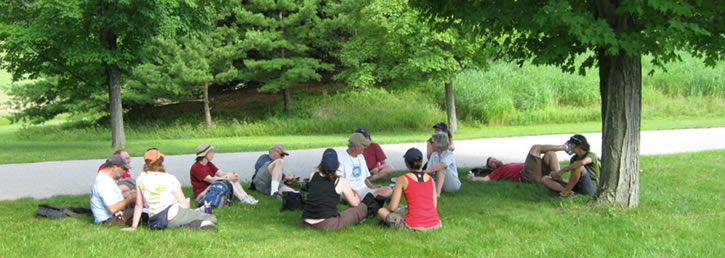 The group gathers to discuss at Storm King Art Center
The group gathers to discuss at Storm King Art Center |
| Upon returning to the R/V Seawolf at our dock at West Point, we said goodbye to our visitors and gathered together to reflect on our experience yesterday in our Highwaterline /Future Coast Exercise. As a group, we discussed the role of social justice, the frightening truths of societal breakdowns and economic recovery, and how we can make positive, creative, and effective change today. |
|
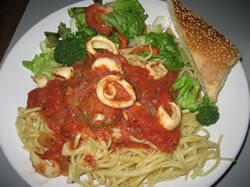 Hearty dinner welcomes the group back to the R/V Seawolf
Hearty dinner welcomes the group back to the R/V Seawolf |
|
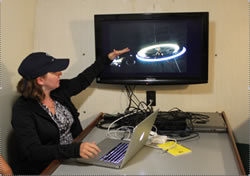 Ann shares a sample of her work
Ann shares a sample of her work |
|
We followed our talk with a dinner break – pasta, calamari, and fresh salad (thanks James!), before sitting down to a fascinating talk with Ann on using art to display scientific data. Are the ways in which artists use data different from the scientific community? A creatively thought-provoking artist, Ann doesn’t think so. With her current project examining the evidence of airborne toxins in the Meadowlands, NJ, she effectively uses scientific data to create beautiful color layering art.
After a day discussing the geologic makeup of the Hudson River, examining how art can be uniquely interactive in nature, as well as display scientific data effectively, Day Four of River Summer came to a satisfying close. |
|
|
|
| |
|
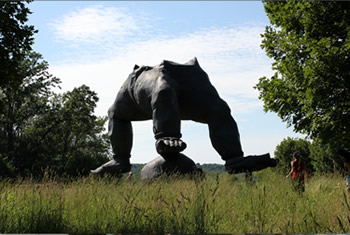 |
|
The thing about climate change is its sheer magnitude. It’s daunting and overwhelming and frightening. You know there are small steps you can take but there prevails a sense of helplessness. It’s almost unfair to have this exercise as we sit here overlooking the river because you know it’s a “framing,” to remind you it will all be taken away if you don’t do something about it now, which ultimately is a great thing, of course, this awakening, a jolt of reality, when your normal reality is coffee, and what’s for dinner, and is it Friday yet? And no matter how urban-yuppie-green market-reusable tote bag, and let’s-recycle-and-compost you are, there’s still more to be done, so get on it, get out there, and spread the word already.
See what I mean about daunting? |
| The best thing about being in nature is being reminded of just how small you are. Get out of your ego and get outside. What’s the world going to be like in 20-30 years? I’m an optimist so I think/hope we continue on this upward trajectory of awareness, that things will be better and we can really learn from mankind’s mistakes. That it will be easier to communicate about climate change and everyone can be on board. Still daunting. It’s like wishing your Mother would just come and fix everything and make it all right again. |
|
|
| |
What a tough topic to battle. Where to start – how to educate, what to do, what we can do at home, work, community?
Why are people having such a hard time?
We are so gluttonous. How do I stop myself from using the dryer – clothes on the line smell good, but feel rough – and of course its more work! With my students, how do I empower them? How do I get their attention? How do I teach them to learn and critically think for themselves? What is air – atmosphere and the sun’s energy. And I’m falling asleep. I want to go about teaching without preaching. Weather patterns, chemistry, burning fossil fuels – these are the central themes to understand climate change. Eyes are shutting… sunglasses. Yes!!! |
|
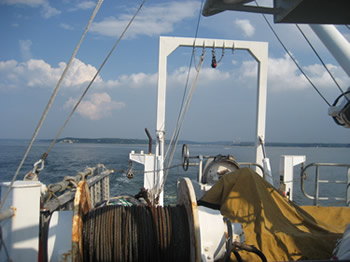 |
| So putting me out in a real setting and looking out, I see the Hudson River – how life will be in ten years, twenty years, will it be over my head? How to capture my students? I feel stuck, paralyzed from moving forward. 350.org, psychology, chemical – emotional – stuck. |
|
|
| |
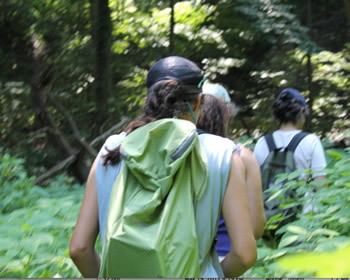 |
|
We warn about it, talk about it, read about it, have guttural reactions to it, and look out for signs of it. Climate change is so large and complex and looming. Will my life actually change as a result of the water level rising? Or will my life change as a result of preparation for a new global plan? I wonder how it feels to the kids born now, and now, and now, and now… To be handed this colossal mess and the responsibility to fix their grandparents problems. Will this next generation be able to keep up with solving so many problems? I wonder if there will be room in the lives of kids born in the summer of 2011 to experience nature firsthand, to hike, and climb, and swim, and sail when they are adults or if their lives will be learning about it, talking about it, reading about it, having guttural reactions to it, and looking for signs of it. |
|
|
| |
| The rhythm of the river is like a magnet that draws with invisible force. Being on the river, your body and mind adopt this rhythm without bothering to ask you about it. When you are on the river, looking at the city, you do not have an impression of the people of the city. Rhythm of the river ebb and flow, but always to the south, the mouth. The city now on a channel carved by forces that dwarf it. The people connect it, knowing and unknowing to this rhythm and these forces, people whose individual acts are too small to alter the course of the forces, but who may find their every individual act influence by them. How will they respond when faced with immediate change? Will individual and local patterns shift in response or will they deny that they have a role? They rhythm will continue, it may be warmer or cooler, but the river will continue in stride. It will adapt. |
|
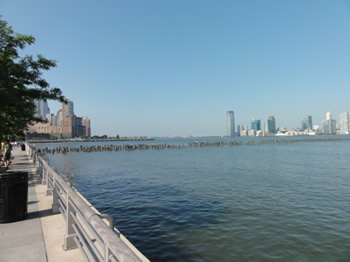 |
|
|
| |
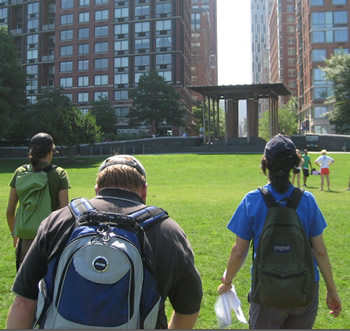 |
|
North of the ferry terminal our north meadow micropark is immaculate and lush (chem lawn?). Ax! Stay on the grass!
Looking across to the Jersey City Financial District with Paul’s Hook and the Colgate sign tucked in behind. The breeze carries some moisture and air conditions the back of my neck. The dock, cranes for oil and shipping in Bayonne are peeking up behind Ellis Island. Yesterday, I learned that the old Erie Railroad station is what sits at the front of Liberty State Park. I can feel the gravitational pull of thirty Starbucks behind me as I try to imagine Hudson River 50 – 100 years ago.
December 2001 was my first Christmas in Hoboken, the day we picked out our tree on Willow Street. It was in the 80s and everyone was wearing shorts.
January 10, 2007 – date #2 with Tony. We’re in Central Park, it’s so warm, the mosquitos have uncurled and we’re getting hot as we walk in the sun.
|
Easter 1980 – the snow at the end of the driveway is double the height of a mailbox. Shenandoah High School parking lot, February 1991 – we strap on roller-skis because it hasn’t snowed at all in weeks and Gloversville is going to kick our asses if we don’t figure out a way to train.
President’s Day, 2002 – the snow is piling up on Greenwich Street, making everything look so clean. It’s luminous under the street lamps at night. The next day, our out-of-town guests are stranded with us. We walk over 40 minutes, shoveling where we think the license plate areas of the cars are before we can excavate our own.
January 2011, 2:30 am – we leave the hospital with Ben and step out into the most dangerous world we’ve ever known. An ice storm has slicked us all and we travel carefully toward our warm nest. |
|
|
| |
Yesterday we were talking about how people reach a sort of saturation point when it comes to worrying about issues – I can’t remember the exact social scientific term – but I feel as though I’ve reached that point. With regard to climate change, I do what I can on a personal level – live responsibly, no car, power strips, CFC’s, recycle – everything I can do whilst still existing in the confines of “regular society.” But it ends there; with regard to changing how we can get our energy, I feel utterly disenfranchised. Beyond whatever I do in education, creating awareness of the issue in the classroom, I am of no service. Should I buy those solar energy credits the college girls were talking about yesterday? Should I go off the grid? |
|
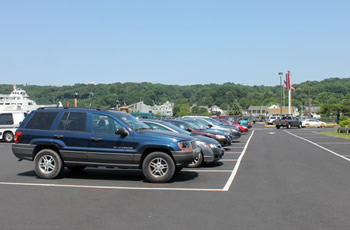 |
| I cannot believe that the replacement solution Cuomo has for shutting down Indian Point is FRACKING. Fracking fracking. Makes my blood boil – such a horrid retrograde alternative--from nuclear power to that? Granted, we’ve all seen the potentially devastating consequences of a meltdown. And maybe that risk becomes elevated in an older reactor like Indian Point, but do we have to reach for the fossil fuels? I’d be all aboard with Cuomo’s agenda if the replacement were alternative energy or even the hydro-Quebec option. But this is so ridiculous. I think the simultaneous solution to several problems in this country, economic and environmental, lies in the development of alternative energy technologies. The fact that our Democratic president hasn’t embraced such initiatives clenches my heart like a fist. |
|
|
| |
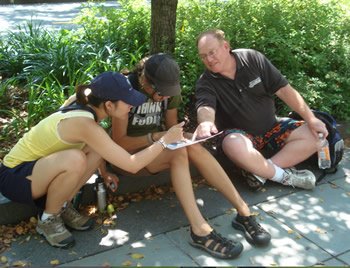 |
|
Climate change is a very discussed topic. It has become something that almost every segment of the population has heard about and yet few have any tangible experience with the impacts.
Is that true?, I ask.
I think that if we stopped to look at some of the subtle indicators, we would find that, in fact, we do have first-hand experience with climate change at multiple levels in our lives. For example, if we look at some of the measurements along our waterfronts, we would see the rate of millimeters a year sea level is creeping up. If we look at our seasonal changes, we would see that our springs and summers are warming a day or two earlier than when we were growing up and our temperatures seem to be different by slight degrees from when we experienced these seasons in our youth. |
| Perhaps the biggest indicators are focused on specific issues of the globe and specific populations. This makes it more difficult to recognize the subtle changes that are occurring. I think of what Ann said of Gil’s ability to point out a process when we are surrounded by subtlety. Perhaps climate needs a Gil to help visualize the evidence, to piece together the small, seemingly insignificant indicators into the lens of a larger picture. Some have tried to step in to do this, but the problems in communication are in delivering the message. Aha! Perhaps we need to merge Sabina and Gil – bring them together to develop a message and a delivery to connect the dots in climate message. |
|
|
| |
The climate is changing always – we are forcing things in our human-centered world but we are living in the abstract, an abstract world that we are deeply vested in.
The “right city, wrong map” was not very useful, eventually the complex reality will catch up and possibly we will be no more able to effect change in any other species – I feel that we as a country have missed the boat, the point, the opportunity. We have a chance to lead, to be a role model, to galvanize, but we’re stuck in a bad model of consumption, growth for growth’s sake. Wasting so much, good at wasting, so busy/overwhelmed that it is hard to take the time to gather the facts to make a decision and determine a direction like we are but a single voice on a cruise liner, seeing that the course will take us on the rocks but nobody cares or worries how to act, think, how to slow down in a speeding up world. Maybe this is what extinction feels like. |
|
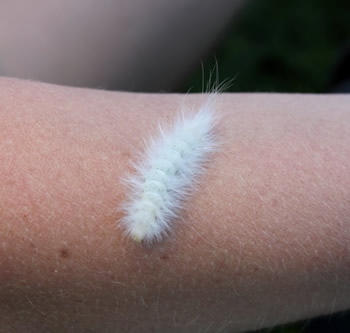 |
|
|
| |
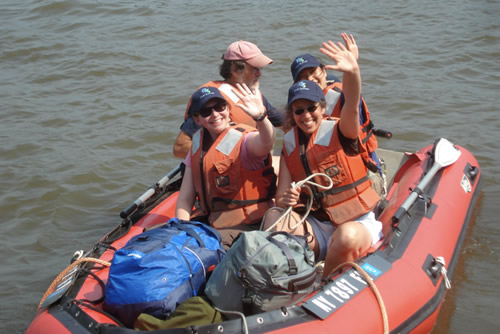 The end of Module I of River Summer 2011
The end of Module I of River Summer 2011
|
|
| |
| |
 |
|




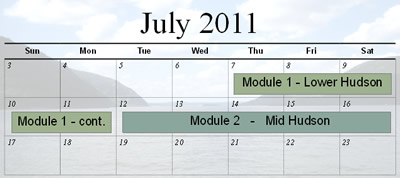



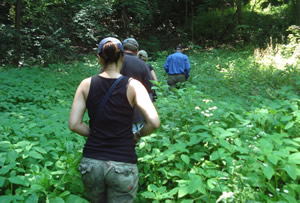
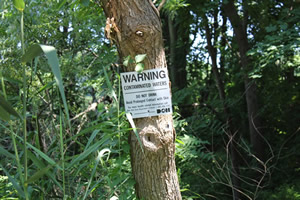


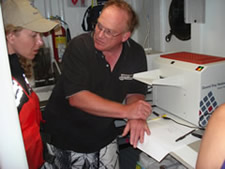
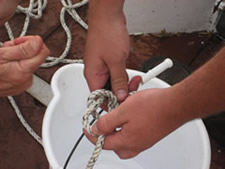
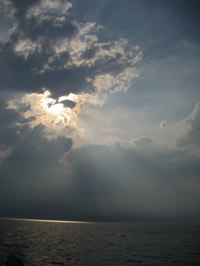












 Biological productivity could also make a contribution to the opacity of the water under the Bridge, making it an apt location for a plankton tow.
Biological productivity could also make a contribution to the opacity of the water under the Bridge, making it an apt location for a plankton tow. 












